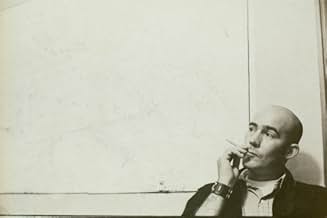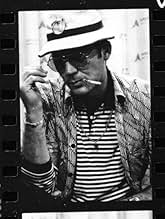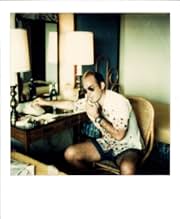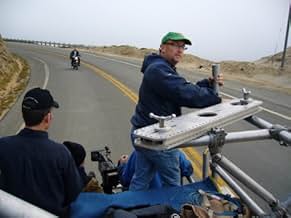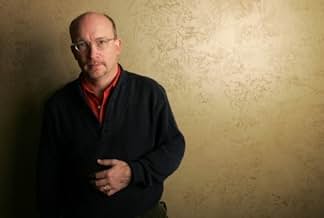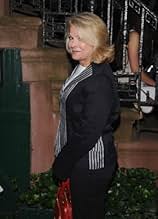VALUTAZIONE IMDb
7,6/10
8684
LA TUA VALUTAZIONE
Aggiungi una trama nella tua linguaA portrait of the late gonzo journalist Hunter S. Thompson.A portrait of the late gonzo journalist Hunter S. Thompson.A portrait of the late gonzo journalist Hunter S. Thompson.
- Regia
- Sceneggiatura
- Star
- Premi
- 1 vittoria e 5 candidature totali
Hunter S. Thompson
- Self
- (filmato d'archivio)
Oscar Acosta
- Self
- (filmato d'archivio)
Muhammad Ali
- Self
- (filmato d'archivio)
Warren Beatty
- Self
- (filmato d'archivio)
Recensioni in evidenza
This is an absorbing doc not only of the good doc but the whole counterculture that he championed in many ways. For all his excessive lifestyle that became almost a parody of the drug culture, he remained a true intellectual and anti-corruption/hypocrisy crusader. He embraced the vision of a new world not ruled by greed and war-mongering, and as early as 1971 proclaimed his great sadness that the movement and the moment of flower power had passed and with it the chance for sane politics. This moment was captured well in "Where the Buffalo Roam" starring Bill Murray as HST, which is given kind of short shrift in this documentary in favor of scenes from "Fear and Loathing Las Vegas" with Johnny Depp as HST. Considering that Depp produced and narrates the film as well as financed the grandiose send-off that Thompson envisioned for himself, it's not strange that Murray's portrayal would be downplayed, as excellent as it was (and Peter Boyle's as the Samoan lawyer.)
All in all, it is a well-balanced account of Thompson's life and work, with many pertinent interviewees like his two wives and son, Jann Wenner of Rolling Stone, Sonny Barger of the Hell's Angels, Jimmy Buffett, George McGovern, Jimmy Carter, Pat Buchanan, Tom Wolfe, and various Aspenites. His passion and wit were undeniable, and his addiction to guns, booze and dope were in many ways forgivable. But his absence in today's disastrous political scene, his voice against war and corruption is sorely missed, and lamented by several of the interviewees. The parallels between Nixon and Bush are easily drawn, and "Gonzo" does this without hammering the point home except to exhort the audience to take up the fight that the Good Doctor waged in a seemingly crazy, but noble and honorable way for most of his life.
All in all, it is a well-balanced account of Thompson's life and work, with many pertinent interviewees like his two wives and son, Jann Wenner of Rolling Stone, Sonny Barger of the Hell's Angels, Jimmy Buffett, George McGovern, Jimmy Carter, Pat Buchanan, Tom Wolfe, and various Aspenites. His passion and wit were undeniable, and his addiction to guns, booze and dope were in many ways forgivable. But his absence in today's disastrous political scene, his voice against war and corruption is sorely missed, and lamented by several of the interviewees. The parallels between Nixon and Bush are easily drawn, and "Gonzo" does this without hammering the point home except to exhort the audience to take up the fight that the Good Doctor waged in a seemingly crazy, but noble and honorable way for most of his life.
After Enron: The Smartest Guys in the Room, Taxi to the Dark Side, and this vivid, significant depiction of the Sixties and Seventies superstar journalist Hunter Thompson, Alex Gibney has emerged as clearly one of the best documentary filmmakers we've got and also one of the most prolific.
Gibney tells a very smart, very verbal, very funny but also intensely significant story here. Some of the people who speak most highly of Thompson on camera are Billy Carter, William McGovern, and longtime Republican presidential adviser Pat Buchanan,as well as writer Tom Woolf and Thompson's editors at Rolling Stone, for which he did his best periodical pieces, the notable ones turned into books. More intimate details--but the man was such a perpetual performer that public and private are hard to separate--come from Thompson's first and second wives. And the English artist Ralph Steadman, who illustrated the writing, has much to say, as do plenty of others. When Steadman first met Thompson he fed the Brit Psilocybin and he was never the same. Steadman became an invaluable cohort and collaborator and his wild drawings provide a perfect visual counterpart to Thompson's written words on screen.
Thompson was a notorious wild man from early on. "I wouldn't recommend sex, drugs or insanity for everyone, but they've always worked for me," he said. Prodigious in his consumption of drugs and alcohol, he was witness to some of the great events of his time, and got deeply involved in politics and opposition to the Vietnam war and of course the counterculture. Lean, athletic, flashily dressed, with trademark balding pate, big sunglasses, cigarette holder and drink in hand, Thompson was a demon at the IBM Selectric, gleefully spinning out brilliant pieces nobody else could have written, a master of outrage and wit.
Fueled by craziness, substances, and his own tongue-in-cheek joie de vivre, he devised his own outrageous style of writing in which cold clear fact was blended with wild invention and the adjectives and metaphors flew like hornets around a honey pot. Others too partook of the kind of journalism he practiced. The times--the flamboyant and boisterous and revolutionary Sixties and early Seventies-- seemed to call for a new more violent, more committed language in journalism. Norman Mailer also wrote about the democratic convention in Chicago in 1968 and on hand for Esquire were the likes of Jean Genet and William Burroughs. Three is something of Burroughs in Thompson, the drugs and the outrage and a way of seeing convention as conspiracy. One of Thompson's famous quotes gives a hint of the link: "America... just a nation of two hundred million used car salesmen with all the money we need to buy guns and no qualms about killing anybody else in the world who tries to make us uncomfortable." This was the moment when the distinction between fiction and non-fiction blurred: Tom Wolfe (The Electric Kool-Aid Acid Test, which used raw material from the more adventurous Thompson), Thompson's act of "embedded journalism" as Wolfe calls it, Hell's Angels), Truman Capote's murder story In Cold Blood done for The New Yorker, were all variations on the idea of the "non-fiction novel." Mailer had done a heroically personal and novelistic account of the 1967 March on the Pentagon, The Armies of the Night. The film might do a bit more to put Thompson in all this context, but it's clearly implied. He called his wild style "gonzo" journalism.
Thompson also wrote about Las Vegas as the American dream and about Nixon, whom he loathed. He also used a tape recorder a lot. This provides great material for the film. So does the Terry Gilliam film version of Fear and Loathing in Las Vegas; and Johnny Depp, who played Thompson in the film and became a great fan and friend, reads salient passages sitting in front of a well-stocked bar. Depp paid for the spectacular monument/funeral for the writer that Thompson had--on film--planned out long before, in which his ashes are fired into the Colorado hills. Ralph Steadman did the sketches. This is shown at the end of the film and provides a lovely son et lumière finale.
Thompson's innate violence may explain how he could have blended in so well for a while with the Hell's Angels. He kept at least twenty firearms on hand in his house, all loaded, his first wife reports. He always planned to end his life with suicide and he shot himself. He did it on a nice day in February almost as a family event, with his son, daughter-in-law and grandson at the house and on the phone with his wife, a shot to the head, at the age of 68, not an act of depression but the completion of a careful plan. It was over. And he had been here to see George W. Bush and predict the decline and fall of the American empire. A late collection of short pieces is entitled Hey Rube: Blood Sport, the Bush Doctrine, and the Downward Spiral of Dumbness.
His dissipation took its toll and so did fame. He fell into playing a self-parodying avatar of himself and his writing deteriorated after the later Seventies, so he had about ten good years and about twenty not-so-good ones. Some have dwelt on his decline; Gonzo doesn't. His writing faltered as early as 1974 when he went to Zaire with Steadman to cover the Foreman-Ali "Rumble in the Jungle" and he got drunk at the pool during the fight and never finished the story. Given how bright he burned and how hard he lived, it was inevitable that the man would burn out early And writing did not by any means fizzle out even into the Nineties. There is an immense wealth of spinoffs on film; Gibney had rich, rich material to work with here.
The best that could happen is that this beautifully edited and greatly entertaining film makes a host of new converts to the writing.
Gibney tells a very smart, very verbal, very funny but also intensely significant story here. Some of the people who speak most highly of Thompson on camera are Billy Carter, William McGovern, and longtime Republican presidential adviser Pat Buchanan,as well as writer Tom Woolf and Thompson's editors at Rolling Stone, for which he did his best periodical pieces, the notable ones turned into books. More intimate details--but the man was such a perpetual performer that public and private are hard to separate--come from Thompson's first and second wives. And the English artist Ralph Steadman, who illustrated the writing, has much to say, as do plenty of others. When Steadman first met Thompson he fed the Brit Psilocybin and he was never the same. Steadman became an invaluable cohort and collaborator and his wild drawings provide a perfect visual counterpart to Thompson's written words on screen.
Thompson was a notorious wild man from early on. "I wouldn't recommend sex, drugs or insanity for everyone, but they've always worked for me," he said. Prodigious in his consumption of drugs and alcohol, he was witness to some of the great events of his time, and got deeply involved in politics and opposition to the Vietnam war and of course the counterculture. Lean, athletic, flashily dressed, with trademark balding pate, big sunglasses, cigarette holder and drink in hand, Thompson was a demon at the IBM Selectric, gleefully spinning out brilliant pieces nobody else could have written, a master of outrage and wit.
Fueled by craziness, substances, and his own tongue-in-cheek joie de vivre, he devised his own outrageous style of writing in which cold clear fact was blended with wild invention and the adjectives and metaphors flew like hornets around a honey pot. Others too partook of the kind of journalism he practiced. The times--the flamboyant and boisterous and revolutionary Sixties and early Seventies-- seemed to call for a new more violent, more committed language in journalism. Norman Mailer also wrote about the democratic convention in Chicago in 1968 and on hand for Esquire were the likes of Jean Genet and William Burroughs. Three is something of Burroughs in Thompson, the drugs and the outrage and a way of seeing convention as conspiracy. One of Thompson's famous quotes gives a hint of the link: "America... just a nation of two hundred million used car salesmen with all the money we need to buy guns and no qualms about killing anybody else in the world who tries to make us uncomfortable." This was the moment when the distinction between fiction and non-fiction blurred: Tom Wolfe (The Electric Kool-Aid Acid Test, which used raw material from the more adventurous Thompson), Thompson's act of "embedded journalism" as Wolfe calls it, Hell's Angels), Truman Capote's murder story In Cold Blood done for The New Yorker, were all variations on the idea of the "non-fiction novel." Mailer had done a heroically personal and novelistic account of the 1967 March on the Pentagon, The Armies of the Night. The film might do a bit more to put Thompson in all this context, but it's clearly implied. He called his wild style "gonzo" journalism.
Thompson also wrote about Las Vegas as the American dream and about Nixon, whom he loathed. He also used a tape recorder a lot. This provides great material for the film. So does the Terry Gilliam film version of Fear and Loathing in Las Vegas; and Johnny Depp, who played Thompson in the film and became a great fan and friend, reads salient passages sitting in front of a well-stocked bar. Depp paid for the spectacular monument/funeral for the writer that Thompson had--on film--planned out long before, in which his ashes are fired into the Colorado hills. Ralph Steadman did the sketches. This is shown at the end of the film and provides a lovely son et lumière finale.
Thompson's innate violence may explain how he could have blended in so well for a while with the Hell's Angels. He kept at least twenty firearms on hand in his house, all loaded, his first wife reports. He always planned to end his life with suicide and he shot himself. He did it on a nice day in February almost as a family event, with his son, daughter-in-law and grandson at the house and on the phone with his wife, a shot to the head, at the age of 68, not an act of depression but the completion of a careful plan. It was over. And he had been here to see George W. Bush and predict the decline and fall of the American empire. A late collection of short pieces is entitled Hey Rube: Blood Sport, the Bush Doctrine, and the Downward Spiral of Dumbness.
His dissipation took its toll and so did fame. He fell into playing a self-parodying avatar of himself and his writing deteriorated after the later Seventies, so he had about ten good years and about twenty not-so-good ones. Some have dwelt on his decline; Gonzo doesn't. His writing faltered as early as 1974 when he went to Zaire with Steadman to cover the Foreman-Ali "Rumble in the Jungle" and he got drunk at the pool during the fight and never finished the story. Given how bright he burned and how hard he lived, it was inevitable that the man would burn out early And writing did not by any means fizzle out even into the Nineties. There is an immense wealth of spinoffs on film; Gibney had rich, rich material to work with here.
The best that could happen is that this beautifully edited and greatly entertaining film makes a host of new converts to the writing.
No holds barred documentary covering the bizarre life of Dr. Hunter S. Thompson - the father of Gonzo journalism.
This film covers all his classic moments:Hell's Angels, Race for Sheriff of Aspen, Fear and Loathing in Las Vegas and on the Campaign Trail; Muhammad Ali vs. George Foreman, George McGovern, Jimmy Carter, etc. The articles he wrote over several decades for Rolling Stone Magazine are given heavy perspective and no one represented the voice of the turbulent 60's and 70's like Hunter aka Raoul Drake.
Great soundtrack, clips & guest from Johnny Depp to Jimmy Buffett. The loss of a great voice we could really use today!
This film covers all his classic moments:Hell's Angels, Race for Sheriff of Aspen, Fear and Loathing in Las Vegas and on the Campaign Trail; Muhammad Ali vs. George Foreman, George McGovern, Jimmy Carter, etc. The articles he wrote over several decades for Rolling Stone Magazine are given heavy perspective and no one represented the voice of the turbulent 60's and 70's like Hunter aka Raoul Drake.
Great soundtrack, clips & guest from Johnny Depp to Jimmy Buffett. The loss of a great voice we could really use today!
Greetings again from the darkness. Another excellent documentary from Alex Gibney, who has also blessed us with "Taxi to the Dark Side" and "Enron: The Smartest Guys in the Room". Here, Gibney takes on the fascinating story of Hunter S. Thompson ... he of Gonzo Journalism.
With enough material to support a mini-series, Gibney culls the material down to two hours and provides some insight, but mostly commentary on this uniquely talented writer and observationalist. The highlights include George McGovern heartfelt description of the man and interviews with Thompson's two wives, and "Rolling Stone" editor Jann Wenner. Through their own words and body language, we get a glimpse into the immense respect this man's talent generated. Of course, no punches are pulled on his weaknesses and transgressions.
I couldn't help but chuckle of the irony as Tom Wolfe, resplendent as always in his tailored white suit, explains that Thompson created this character and its uniform/costume and felt the burden of living up to his legendary exploits. He was a captive of his own creation.
While it is difficult to understand how someone with such self-destructive tendencies captured the respect of so many close to him, Thompson is truly an interesting and fascinating topic and was right in the middle of much of the history of the 60's and 70's. Quietly narrated by Thompson's friend, Johnny Depp, the film uses many topical songs selections to accompany moments in time.
With enough material to support a mini-series, Gibney culls the material down to two hours and provides some insight, but mostly commentary on this uniquely talented writer and observationalist. The highlights include George McGovern heartfelt description of the man and interviews with Thompson's two wives, and "Rolling Stone" editor Jann Wenner. Through their own words and body language, we get a glimpse into the immense respect this man's talent generated. Of course, no punches are pulled on his weaknesses and transgressions.
I couldn't help but chuckle of the irony as Tom Wolfe, resplendent as always in his tailored white suit, explains that Thompson created this character and its uniform/costume and felt the burden of living up to his legendary exploits. He was a captive of his own creation.
While it is difficult to understand how someone with such self-destructive tendencies captured the respect of so many close to him, Thompson is truly an interesting and fascinating topic and was right in the middle of much of the history of the 60's and 70's. Quietly narrated by Thompson's friend, Johnny Depp, the film uses many topical songs selections to accompany moments in time.
Hunter S. Thompson was an often astute commentator of American life, and an always astute commentator of his own mental disintegration, a process driven by his own enthusiastic use of mind-altering drugs; a gun freak who opposed American involvement in Vietnam; and a critic of capitalism who became, pretty much, the living embodiment of his own brand. He also, years after his best work was done, died by shooting himself. This documentary provides insight into his strange journey, which does have a tragic dimension: the values of the life he lived, the adulation he received for living it and the damage it did to him appear in the end inseparable. By the end, he was still celebrated (by new generations of kids who love to get high) but no longer relevant, his final act a desperate (and arguably failed) plea for attention. This documentary tells us much of the story, mostly interestingly, though there are times when it fails to disentangle the process it describes, the overwhelming of man by self-created myth. Still, while it's the prerogative of every generation to feel jaded, I find it hard to imagine another figure like Hunter emerging today, if only because a large part of his quality was that no-one expected him. But the film reminds you of another part as well: he could certainly write.
Lo sapevi?
- QuizAt 1:35 you can see a Richard Nixon mask under the TV. This is a nod to the 1980 movie "Where The Buffalo Roam" starring Bill Murray as Thompson, where he uses that mask to train his dog to attack a scarecrow-like recreation of the former President.
- BlooperWhen the film mentions that Hunter Thompson had a crush on Jefferson Airplane singer Grace Slick, archival footage instead shows the Airplane's first female singer, Signe Anderson.
- ConnessioniFeatures To Tell the Truth (1956)
I più visti
Accedi per valutare e creare un elenco di titoli salvati per ottenere consigli personalizzati
- How long is Gonzo?Powered by Alexa
Dettagli
- Data di uscita
- Paese di origine
- Sito ufficiale
- Lingue
- Celebre anche come
- Politicamente Scorretto - The Hunter S. Thompson's Gonzo
- Aziende produttrici
- Vedi altri crediti dell’azienda su IMDbPro
Botteghino
- Lordo Stati Uniti e Canada
- 1.252.100 USD
- Fine settimana di apertura Stati Uniti e Canada
- 191.942 USD
- 6 lug 2008
- Lordo in tutto il mondo
- 1.491.958 USD
- Tempo di esecuzione
- 2h(120 min)
- Colore
- Mix di suoni
- Proporzioni
- 1.85 : 1
Contribuisci a questa pagina
Suggerisci una modifica o aggiungi i contenuti mancanti



